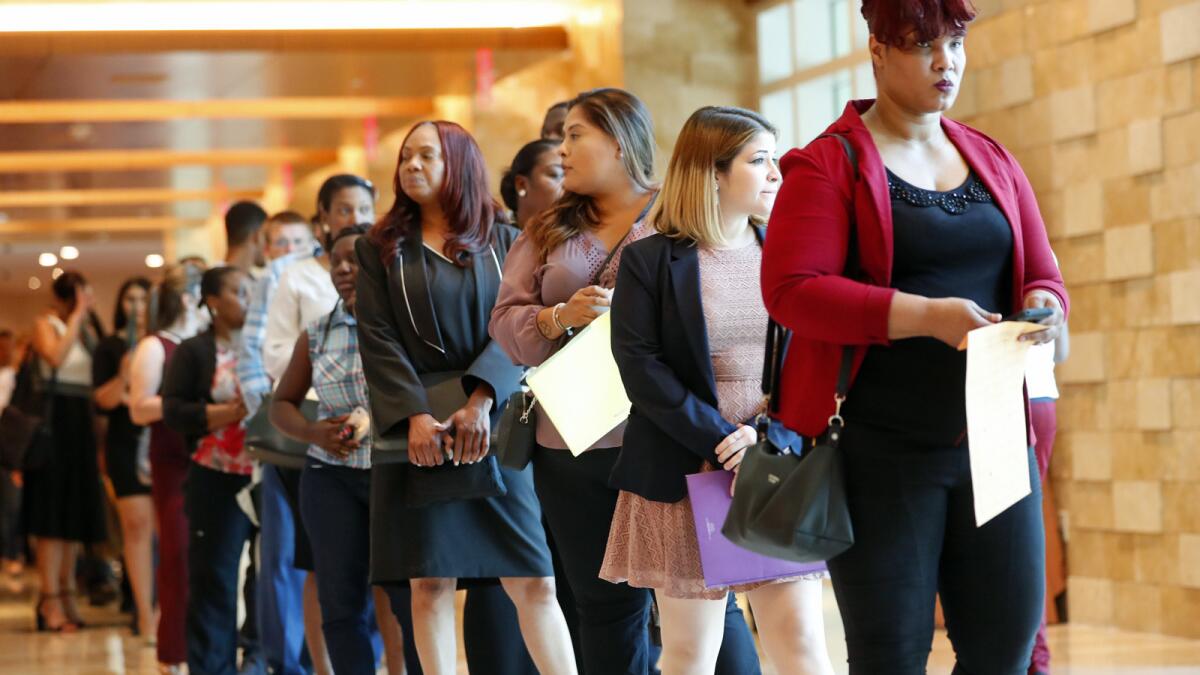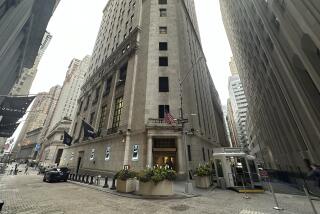U.S. job growth rebounds in June, lowering Fed’s incentive to cut interest rates

Reporting from WASHINGTON — U.S. employers sharply stepped up their hiring in June, adding a robust 224,000 jobs, an indication of the economy’s durability after more than a decade of expansion.
The strength of the jobs report the government issued Friday could complicate the Federal Reserve’s decision this month on whether to cut interest rates to help support the economy. Most investors have anticipated a rate cut in July and perhaps one or two additional Fed cuts later in the year. That scenario may be less likely now.
Stocks fell early Friday before regaining much of that ground. The yield on the 10-year U.S. Treasury note climbed to 2.04% — from just under 2% before the jobs report — reflecting a view that the Fed might now be less inclined to cut rates multiple times.
June’s solid job growth followed a tepid gain of 72,000 jobs in May, a result that had fueled concerns about the economy. But with June’s pace of hiring, employers have now added, on average, a solid 171,000 jobs for the last three months. Last month’s burst of hiring suggests that many employers have shrugged off concerns about weaker global growth, President Trump’s trade wars and the waning benefits from U.S. tax cuts.
“Although there are drags on the economy in 2019, the expansion should continue through this year,” said Gus Faucher, chief economist at PNC Financial Services. “The doom and gloom was overblown.”
The unemployment rate ticked up to 3.7% in June from 3.6% the previous two months, reflecting an influx of people seeking jobs. Average hourly wages rose 3.1% from a year earlier — a smaller jump than was projected.
Trump responded to Friday’s jobs report by tweeting, “JOBS, JOBS, JOBS!” But the strong hiring gains have lessened the case, at least for now, for the Fed to slash rates as Trump has repeatedly and aggressively pressed the central bank to do.
“If we had a Fed that would lower interest rates, we’d be like a rocket ship,” the president told reporters Friday. “But we’re paying a lot of interest, and it’s unnecessary. But we don’t have a Fed that knows what they’re doing.”
Trump has repeatedly boasted that the U.S. economy is in the best shape ever. Despite that, he has made repeated calls for the Fed to cut interest rates as the record economic expansion shows other signs of slowing — just as the 2020 presidential campaign begins.
Last year, Fed officials raised rates four times, in part to stave off the risk of high inflation and in part to try to ensure that they would have room to cut rates if the economy stumbled.
On Friday, the Fed reiterated that it would act as necessary to sustain the economic expansion, while noting that most Fed officials have lowered their expectations for the course of rates. The central bank’s statement came in its semiannual report on monetary policy.
In Friday’s jobs report for June, the hiring gains were broad. Construction companies added 21,000 workers after having increased their payrolls by only 5,000 in May. Manufacturers hired a net 17,000 people, up from just 3,000 in May. Healthcare and social assistance gained 50,500 jobs. Transportation and warehousing companies’ payrolls grew by 23,900.
The government sector was a major source of hiring, adding 33,000 jobs in June. Nearly all those gains were at the local level.
For Todd Leff, chief executive of Hand & Stone Massage and Facial Spa, the resilience of the U.S. job market has provided both an opportunity and a challenge. With more Americans earning steady paychecks, demand for massages and facials has increased, and the company plans to add 60 locations this year and about 1,800 jobs. But the low unemployment rate has also made it hard to find and retain workers.
“We could hire 1,000 more employees today — if they were available,” said Leff, whose company has about 430 locations and is based in Trevose, Pa.
Investors have been turning their attention to the Fed, which has expressed concern about threats to the economy — especially the uncertainties from Trump’s trade wars — and about inflation remaining persistently below its 2% target level. A Fed interest rate cut, whenever it happens, would be the central bank’s first in more than a decade.
Joshua Shapiro, chief U.S. economist for the consultancy MFR, said the likelihood of a Fed rate cut this month is now slightly lower, though he still estimates that the federal funds rate — what banks charge one another — will be sharply lower by the end of next year.
Ryan Wang, U.S. economist at HSBC Bank, suggested that the solid jobs report might create a communications challenge for Fed Chairman Jerome Powell when he testifies Wednesday and Thursday to congressional committees.
The financial markets still foresee a rate cut of 25 basis points this month, Wang said, adding: “It will be important to see if Chair Powell lays out ... a strong case for near-term monetary easing in his testimony next week.”
Avery Shenfeld, chief economist at Canadian Imperial Bank of Commerce, is not confident that the Fed will lower rates this month. “We’ve always seen a more notable deceleration in employment ahead of a cut,” Shenfeld said. “I’m not as convinced as the market that the Fed has to move in July. Rate cuts are likely coming, but the Fed has to be very careful to not be seen as pushed by the market and the White House.”
The sluggish pace of hiring in May had signaled that employers might have grown more cautious because of global economic weakness and, perhaps, some difficulty in finding enough qualified workers at the wages that companies are willing to pay.
The pace of the overall economy is widely thought to be slowing from annual growth that neared a healthy 3% last year. Consumer spending has solidified. Home sales are rebounding. But America’s manufacturing sector is weakening along with construction spending. Growth in the services sector, which includes such varied industries as restaurants, finance and recreation, slowed in June.
Overall, though, employers have been adding jobs faster than new workers are flowing into the economy. That suggests that the unemployment rate will remain near its five-decade low and that the economy will keep growing, even if only modestly.
Bloomberg was used in compiling this report.
More to Read
Inside the business of entertainment
The Wide Shot brings you news, analysis and insights on everything from streaming wars to production — and what it all means for the future.
You may occasionally receive promotional content from the Los Angeles Times.










